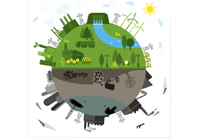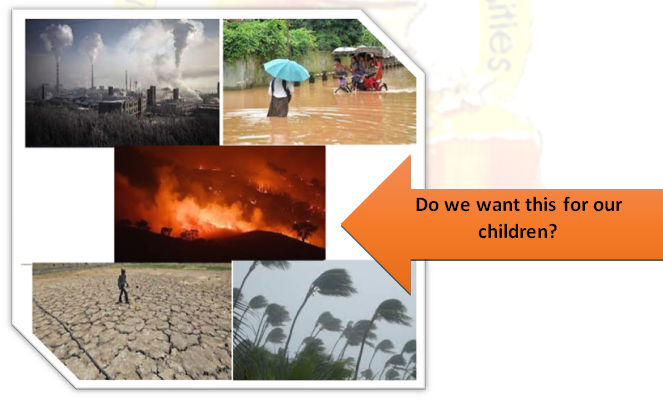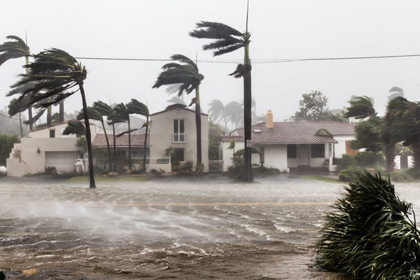About the Climate Action Initiative

The need for climate action: Ever since the onset of the
industrial age, impact of man on the global climate and ecology
has been on a scale that could not have been imagined in the
preceding ages.
Scientific data shows that the global average temperature has
risen by around 1°C since pre-industrial times. The magnitude
and pace of warming of global weather, can no longer be
attributed to long cycle variations in global climate alone. In
fact, the data having been painstakingly gathered ever since
1950s clearly shows that something other than pure natural
forces is to be blamed.
And, a simple application of logic reveals that there is only
one factor that has changed drastically over this period, and
that one factor is human impact on environment. This same
conclusion was achieved, when, the vast data, gathered over the
last 50 years or so, was used to carry certain statistical
examinations through tools such as correlation, regression etc.
Each of those statistical tests gave a certain kind of
relationship between the global climate change and the various
variables thought to be responsible for the same. Among those
multitudes of statistical relationships between various
variables, one relationship that repeated itself most
consistently, was the one that said that there was very high
positive correlation between worsening global climate and the
rising severity of human activity on the climate.
Subsequently, several more such tests were conducted using other
data sets, using ever more powerful supercomputers with
staggering computing powers. But, with a few exceptions here and
there, that too not very credible, now, almost every
climatologist worth his salt, agrees, that it is human
footprint, manifesting itself through parameters such as
emissions of greenhouse gases (GHGs), aerosols and changes in
land use and land cover (LULC), that have substantially altered
the equilibrium of the global climate.
Terrifying pieces of evidence in the form of warming of the
ocean waters resulting in significant weather anomalies such as
frequent heat waves, droughts, heavy precipitation, and severe
cyclones, changes in wind patterns (including shifts in the
global monsoon systems), warming and acidification of the global
oceans, melting of sea ice and glaciers, rising sea levels, and
changes in marine and terrestrial ecosystems, is now staring
directly into our eyes.
In fact, according to the opinion of substantial majority of
climatologists, the rate of change seems to be gathering pace,
and, unless urgent measures are implemented, we would be staring
at the bleak prospect of staring onto the point of no-return.
And, even more alarming is the prospect that if we procrastinate
any further, we would probably not be able to do anything to
avert the unspeakable human disaster that would be our ultimate
undoing.
Scary Future of Global Climate:
Available data, and projections based upon the same, indicate
that none of the really important factors driving climate
change, factors such as global economy, changing consumption
patterns, are really going to change in any meaningful way to
make any worth-while impact on the global climate.

Global climate models developed by experts point at a scenario
where we would most likely have a continuation of human-induced
climate change during the twenty-first century and beyond. And,
projections from these very models show that if meaningful
changes are not introduced in a timebound manner to check GHG
emissions, the global average temperature is likely to rise
within a range of 3° to 5°C, and possibly more, by the end of
the twenty-first century.
In the context of the current global ambitions to check
human-induced environmental degradation, it must be noted that
even if all the targets under commitments such as Paris Accord,
Kyoto Protocol etc are met, we would still have to contend with
a minimum average jump in temperature of around 3°C by the end
of the century. Moreover, this temperature fluctuation will not
be uniform across the planet; some regions will most likely
suffer more severe warming than the global average. Such large
changes in temperature will greatly exacerbate other changes
that are already underway in global climate system, such as the
changing wind, precipitation and temperature extremes.
Even today, when the global temperature has risen only by a
little over 1°C, we can see certain parts of the world being
frequently pummelled by ever more destructive cyclones, forest
fires, blizzards in some parts and intense heat waves in certain
others, irregular rainfall etc. While the whole world is
suffering and would suffer even more if the situation worsens.
But, it is also true that poorer countries would be the worst
sufferers since they would not be able to make investments to
create infrastructure to withstand the impending ferocity of
nature.
One shudders to think what would happen if currently fertile
regions of the world go try and infertile, what would happen if
the global food production is not able to keep in pace with the
expected rise in global population, where would the vast
multitudes of the global poor go, if agriculture, which depends
directly upon climate remaining favourable, collapses?
Climate Conservation Movement – Journey over the Years:
Year Seminal Event
1972 The United Nations Conference on the Human Environment
(also known as the Stockholm Conference) was an international
conference convened under United Nations auspices held in
Stockholm, Sweden from June 5-16, 1972. It was the UN's first
major conference on international environmental issues, and
marked a turning point in the development of international
environmental politics.
1987 Signing of Montreal Protocol. It bound member states to act
in the interests of human safety even in the face of scientific
uncertainty
1988 Intergovernmental Panel on Climate Change (IPCC) founded
under the leadership of Mr. Bert Bolin. It is headquartered at
Geneva. UNEP and World Meteorological Organization (WMO) are its
parent organizations.
1992 Rio Convention held. The United Nations Conference on
Environment and Development (UNCED), also known as the 'Earth
Summit', was held in Rio de Janeiro, Brazil, from 3-14 June
1992. This global conference, held on the occasion of the 20th
anniversary of the first Human Environment Conference in
Stockholm, Sweden, in 1972, brought together political leaders,
diplomats, scientists, representatives of the media and
non-governmental organizations (NGOs) from 179 countries for a
massive effort to focus on the impact of human socio-economic
activities on the environment. A 'Global Forum' of NGOs was also
held in Rio de Janeiro at the same time, bringing together an
unprecedented number of NGO representatives, who presented their
own vision of the world's future in relation to the environment
and socio-economic development.
1992 Rio earth summit of 1992 saw the birth of the Conference of
Parties (CoP) as the supreme decision-making body under UNFPCC.
First CoP was held in Bonn in 1995 and ever since it has been
meeting on an annual basis at different locations. The COP has
met each year since 1995 to review the implementation of the
Convention. Each COP elaborates and builds on the decisions and
resolutions of previous COPs, with the Kyoto Protocol adopted at
COP3 in 1997 being one of the better-known agreements. At COP21
in Paris, “Paris Agreement" was reached and has been widely
proclaimed as a historic deal and one that will inevitably lead
to decarbonisation. The implementation of the Paris Agreement
was to be at the centre of negotiations for COP22 in Marrakech.
1994 The UNFCCC entered into force on 21 March 1994. Today, it
has near-universal membership. The 197 countries that have
ratified the Convention are called Parties to the Convention.
Preventing “dangerous” human interference with the climate
system is the ultimate aim of the UNFCCC.
1997 Signing of Kyoto Protocol. The Kyoto Protocol, which was
signed in 1997 and ran from 2005 to 2020, was the first
implementation of measures under the UNFCCC. The 1st Conference
of the Parties (COP-1) decided that the aim of Annex I Parties
stabilizing their emissions at 1990 levels by the year 2000 was
"not adequate", and further discussions at later conferences led
to the Kyoto Protocol in 1997. The Kyoto Protocol established
legally binding obligations under international law, for
developed countries to reduce their greenhouse gas emissions.
The Kyoto Protocol was superseded by the Paris Agreement, which
entered into force in 2016.
2016 Signing of the Paris Accord. The Paris Agreement is a
legally binding international treaty on climate change. It was
adopted by 196 Parties at COP 21 in Paris, on 12 December 2015
and entered into force on 4 November 2016. Its goal is to limit
global warming to well below 2, preferably to 1.5 degrees
Celsius, compared to pre-industrial levels. To achieve this
long-term temperature goal, countries aim to reach global
peaking of greenhouse gas emissions as soon as possible to
achieve a climate neutral world by mid-century. The Paris
Agreement is a landmark in the multilateral climate change
process because, for the first time, a binding agreement brings
all nations into a common cause to undertake ambitious efforts
to combat climate change and adapt to its effects.
2017 United States under the leadership of President Trump
decided to withdraw its consent to the Paris Accord. This
represented the gravest ever challenge to global climate
preservation efforts, ever since the same were set rolling
during the Stockholm Conference in 1972. USA, being the richest,
most influential country also happens to be the source of
largest GHG emissions in the world. Withdrawal of USA was
considered a mortal blow to international efforts.
2021 The new US president Mr. Joe Biden decided to bring US back
into the fold of Paris Accord, thus effectively reviving the
campaign..
Note on Confidentiality
It is a property of Inter-University Research Centre (IURC)
which is a platform floated by Confederation of Indian Universities (CIU), an
apex body of around 1200 universities and university level institutions in
India.
The information in this website are meant for the exclusive consumption of
people associated with CIU and IURC. If anyone else happens to find this
document or any part thereof, the person is requested to immediately get in
touch with the office of either CIU or IURC and return the document to our any
of our officers.
Unauthorized accessing, publication, whether in part or in full, or sharing &
distribution of the contents of this document without the prior approval of IURC,
is an offence. The same, if brought to the notice of IURC or CIU, would be
considered an infringement of our intellectual property, and the organization
would consider itself free to pursue appropriate legal action
Purpose of this Information
This document is not a scholarly writing on the topic of
human induced climate change. It is a document that has been prepared with the
intention of introducing the idea called Inter-University Research Centre (IURC)
which has been floated recently by Confederation of Indian Universities (CIU).
Through this document, an attempt has been made to explain what CIU is and what
it does. This document also explains what IURC is and what its relationship with
CIU is. This document also contains brief introduction about all that IURC
intends to pursue in near future, including what it plans to do for the cause of
climate preservation.
Finally, this document should be seen as a call to collaboration, going out from
one organization in India to all other like-minded people and organizations all
over the world
.
Effects of Climate Change





